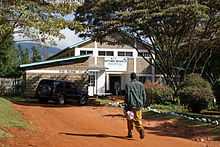Kapsowar
Kapsowar is a small town Elgeyo-Marakwet County in the former Rift Valley Province, Kenya. In 1994 Kapsowar became the headquarters of the former Marakwet District. Prior to this, the Marakwet and Keiyo tribes were collectively grouped into the Elgeiyo-Markwet District. In 2010, the two districts were again merged into Elgeyo-Marakwet County. The Marakwet number approximately 200,000 and a part of the Kalenjin family of tribes, which collectively are the second largest ethnic group in Kenya.
The town is located between the Kerio Valley and the Cherangani Hills and sits at an elevation of 7,500 feet (2,300 meters). The land surrounding Kapsowar is very fertile and the elevation creates a mild climate with a temperature range of 70-85 °F (21-29 °C). Kapsowar has a population of 9152 (1999 Census, total population of the Kapsowar location) . AIC Kapsowar Hospital, established by Africa Inland Mission in 1933, is largely responsible for the degree of development presently seen in Kaposwar.
Kapsowar is largely populated by the Marakwet, a Kalenjin sub-tribe. The original inhabitants of Kapsowar originate from different clans. Among the most prominent are Kapterik, Talai and Kapswahili. The Kapswahili originally immigrated from Tanzania and more or less were absorbed by the Kapterik clan. Although there have been high rates of intermarriage among the Kapswahili, most have retained their Swahili names. The Talai and Kapterik are rival clans with the former being predominantly Protestant and the latter Catholic. They also tend to support rival candidates in parliamentary and local elections. There are cultural, political and religious differences between the Kapterik and the Talai clans as mentioned before. These are assumed to have been preexisting for a long time before the arrival of Christian missionaries. The kapterik are a large clan who have relatives both in Kapsowar and neighbouring areas as well as down to the underlying Kerio Valley. Those on the valley would migrate to the larger Kapsowar area because of the mild climate and better possibilities of farming and livestock keeping. This was though to the displeasure of the Talai because this meant a competition of available resources with the immigrants.
The second and more prominent cause of these rivalries started when the Christian missionaries arrived. Two groups showed up in the pre-colonial period: the Protestant English missionaries under the African inland mission and the catholic Irish missionaries. These two groups brought their animosities with them from Europe with Christianity. In the pursue of followers they used two differing methods: The English missionaries used an assimilitation policy to win followers. This meant convincing the locals to abandon their traditional way of life (polygamy, traditional alcoholic drinks, traditional weddings, traditional circumcision etc.). If they did this, they were given privileges such as being part of the running of different facilities brought by the missionaries and benefitting from them. The British missionaries established the Kapsowar hospital, schools and many other goodies to benefit and convince followers. The Talai, for their part, were convinced of this. There are reports of people denied treatment in Kapsowar hospital in the 70s because they were either non Protestants or they consumed alcohol. Nowadays religion plays only a peripheral role when it comes to treatment. The Irish more of used an integration policy. They converted especially the traditionally conservative Kapterik to Catholics and did not demand them to abandon their traditions. This led to the Kapterik still practicing a more traditional lifestyle. Many Kapterik boys get traditionally circumcised (and unfortunately til recent times some girls too, this is mostly the area where female genital mutilation is still active in the greater Kapsowar area). The traditional circumcision involved an initiation ritual were boys are taught traditions, undergo a bravery test and learn a unique language (understandable only to initiated boys with a word assortment mostly not traceable to the usual Marakwet language but with the usual grammar). With this language, a person speaking fluent Marakwet can be present and would not understand a word. In such a situation, the men would teasingly politely explain to the one not understanding (almost like to a child) and then excuse himself by his comrades with the word ``kaplinsi´´, after a famous missionary formerly of Kapsowar hospital who made great efforts (with remarkable success in the Talai clan) to have Marakwet boys circumcised in hospital and not in the bush. These historical factors led to the Catholic Church in Marakwet being considered liberal and the Protestant church conservative, a total paradox to the known European relations.
-
Surrounding hills with Mt. Kipkinurr in background
-

Marakwet women carrying firewood
-

Marakwet woman holding her child in front of her house
-

Outpatient Department of AIC Kapsowar Hospital
